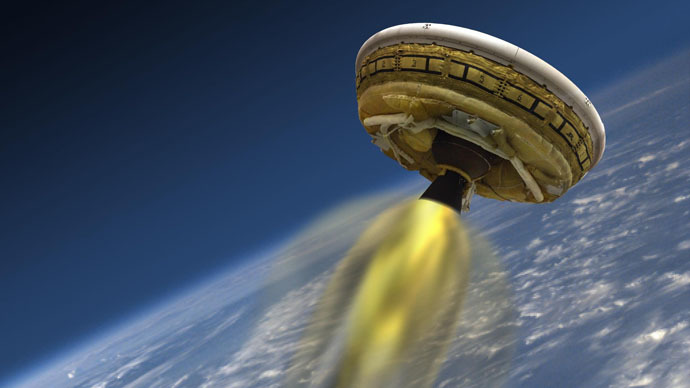NASA testing ‘flying saucer’ Mars lander

Humanity may one day be landing on Mars in flying saucers, if NASA’s test of the new lander design proves successful. A rocket-powered disc with an inflatable donut-shaped balloon on top is intended to replace the 1970s landing technology.
Dubbed the “Low Density Supersonic Decelerator” (LDSD), the vehicle is supposed to make it possible to “safely land heavier spacecraft on Mars.” The idea is to use the balloon cover as a “drag device,” to safely decelerate in the thin Martian atmosphere from almost hypersonic speeds to twice the speed of sound (Mach 2). A parachute would then slow the LDSD down to subsonic speeds, and it would land using stabilizer rockets.
The four stabilizer rockets will be tried out in Tuesday’s “spin-table” test, at the Jet Propulsion Laboratory in Pasadena, California.
Current technology, first used in the 1970s to land the Viking probes, can only land about one metric ton on Mars at a time. More capacity is needed to establish any sort of long-term human presence on the Red Planet.
Future of Mars landing - today! MT“@NASAJPL: 11:30am PDT #LDSD on http://t.co/GvN78TNLqj Tag Qs #AskNASApic.twitter.com/P1SpjHuJG0”
— Bobak Ferdowsi (@tweetsoutloud) March 31, 2015
“The new drag devices are one of the first steps on the technology path to landing humans, habitats and return rockets safely on Mars,” NASA said in a statement. Testing will be conducted through 2015, with potential launch to Mars as early as 2020.
NASA describes the drag devices as “very large, durable, balloon-like pressure vessels that inflate around the entry vehicle,” slowing it down from speeds over Mach 3.5 to Mach 2 or lower, whereupon a parachute 30.5 meters in diameter would deploy and slow the entry vehicle down to subsonic speeds.
Two of the inflatable cover designs, one with a diameter of 6 meters, another with a diameter of 8 meters, are currently undergoing testing. If Tuesday’s stabilizer test is successful, the next step would be sending the vessel to orbit from a test facility in Hawaii.












